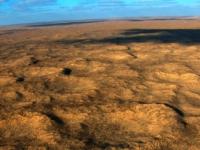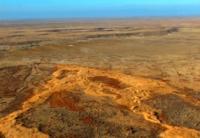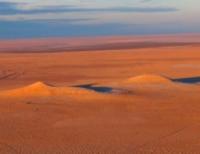Вы здесь
Meteoric crater Shiili.




Tours in Central Asia and Kazakhstan.
"For a long time gloomy druids,
Sybil of the Gloomy Kings
Mark some grievances
He was called from the seas."
Nikolai Gumilev. "A rock". A.I. Gumileva.
Exclusive tours in Kazakhstan.
Shiili Meteorite Crater (Chiuli) - 5.5 kilometers in diameter is located in Western Kazakhstan in the Aktobe region. It is located about 320 kilometers north of the Aral Sea. It is assumed that the fall of the meteorite occurred 46 ± 7 million years ago in the Eocene era.
The diameter of the Shiyli crater of the astrobleme was estimated using an empirical relationship that relates its size to the diameter of the center of the uplift. The first information about this structure was obtained by A. A. Stepankova in the 1950s; a large amount of volume was made on this structure and its environs in 1951 - 1954. drilling operations.
The results of these studies showed that the buried area of the Permian saliferous strata of the basement is wedged out several kilometers west of the dome, and dense terrigenous deposits of the Lower Carboniferous lie immediately below the object.
Moreover, the dome itself is without a root structure, which is localized only in the rocks of the Meso-Cenozoic cover. (Vishnevsky, Korobkov, 1989). The Shiyli dome in the Western Primugodzharya is the central uplift of the eroded marine impact structure in loose Mesokainozoic sediments.
It has a diameter of 1.2 km and is surrounded by an annular subsidence of adjacent rocks. In the rocks of the structure, macroscopic (shock cleavage, breccia “gris”, shock cones and shock mirror mirrors) and microscopic (planar structures in quartz) signs of weak shock metamorphism were found.
The reconstruction of the astroblem formation process shows that the Shiili impact event occurred in a shallow, ~ 350 m, Eocene sea basin and, in terms of its energy equivalent, corresponded to a crater with a diameter of ~ 3.2 km.
The central uplift of the astroblem arose as a result of the elastic recoil of the target rocks. In conditions of water cover, the impacted Shiyli crater was very shallow, ~ 50 m deep, or absent; perhaps in the latter case, only centrifugal spreading of bottom sediments occurred around the core of the structure, including the central uplift and annular subsidence of the target rocks.
The reconstructed diameter of the Shiili astrobleme is overstated. According to the original data of the authors (Vishnevsky, Korobkov, 1989), its diameter is estimated at 3.2 km.
Authority:
(Vishnevskii S.A., Korobkov V.F., 2004). (Vishnevskii S.A., 2007).
Photos
Alexander Petrov.







